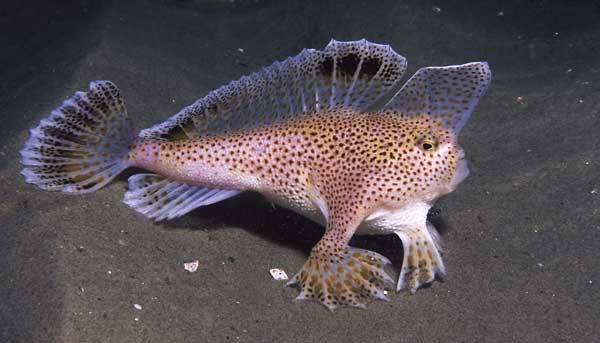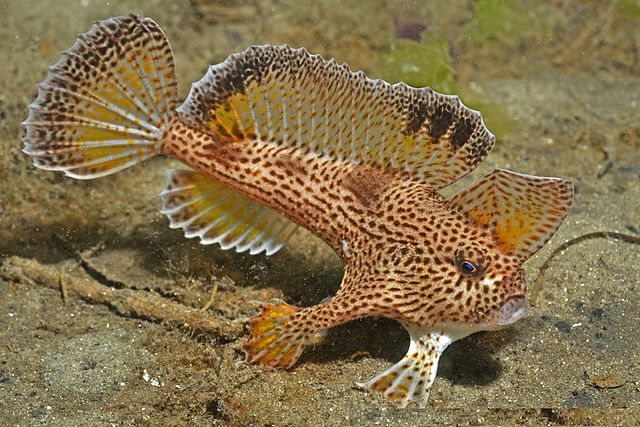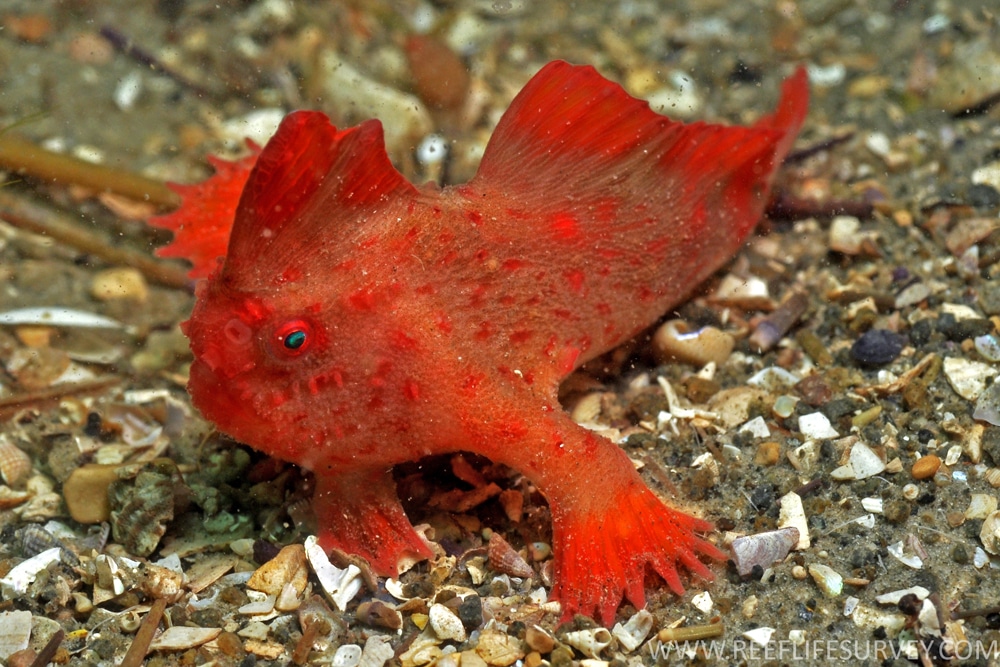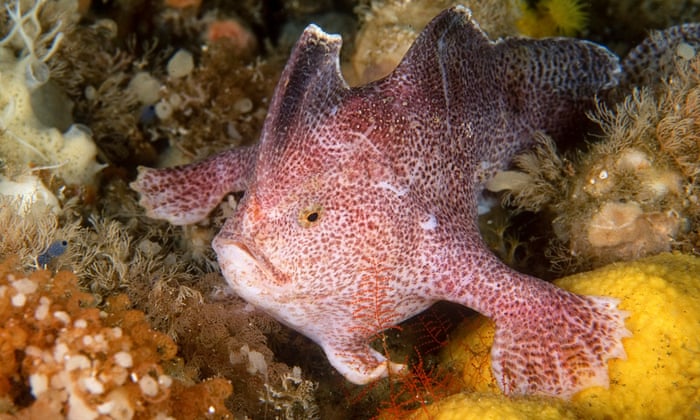Handfish is a type of anglerfish that belongs to the Brachionichthyidae family. The handfish group comprises five genera and 14 extant species. These fishes are known for their unusual way to propel themselves by walking on the seafloor rather than swimming. Today the Handfish are mainly found in the coastal waters of southern and eastern Australia and Tasmania.
They can grow up to 15 cm (5.9 in) long and their skin is covered with tooth-like scales, giving them the alternate name warty anglers. They are slow-moving fish that prefer to ‘walk’ rather than swim. They are benthic fishes, which prefer to hang around the sandy and rocky bottoms of the seafloor.
They use their modified pectoral fins to walk on the seafloor. These modified fins have the appearance of hands with fingers as well, hence their name is Handfish. Also, they have a mohawk-like fin on their head, pretty cool.

Very little is known about handfish because their typically small population sizes and restricted distributions make them highly vulnerable to disturbance. But it sure that this weirdly amazing fish is facing extinction with some species already extinct. About 200 years ago, the smooth handfish was plentiful in Australia and Tasmania.
It was the first fish species to be scientifically documented. In 1802, French naturalist François Péron discovered the first specimen of the weird-looking creature in southeastern Tasmania. Now The Spotted, the Red, and Ziebell’s handfish are critically endangered and are faced with increasing levels of habitat destruction and loss, pollution, and changing climate. We can clearly say it is now one of the rarest fish in the world.
Spotted Handfish

The Spotted handfish is a rare species in the handfish family, Brachionichthyidae. They are found only in the estuary of Derwent River, Tasmania, and nearby areas. They are found at depths of 5 meters to 10 meters on the seafloor. Spotted handfishes can reach 6 inches in length. Spotted handfishes have creamy-white skin on the back covered with brown or yellowish-brown spots and white skin on the belly. Each spotted handfish has a unique pattern of spots on its body.
Fewer than 3000 individuals remain in the wild and they are considered Critically Endangered. They are classified as critically endangered on the IUCN Red List 2020. The main threat posed to spotted handfish’s existence is by the introduction of species of a seastar, the Northern Pacific seastar, which prey on these fish’s eggs.
Red Handfish

The Red handfish is a species of handfish in the genus Thymichthys. They are found only in Frederick Henry Bay, Tasmania. They are easily recognized by their relatively small size and red coloration among other handfishes. On average, the standard length of red handfish is about 61.4 mm (2.4 in) with an average total length of 80.1 mm (3.2 in).
They vary in color from bright red to light pink-brown. Red color on both body and fins, with a black line separating the white fin edges. And a pink color variant with a body covered in many red patches, with translucent pink fins expressing some bright red patches.
Only a few groups of 20-40 of these fishes remained in Frederick Henry Bay, Tasmania. But in 2018 a group of drivers encountered a new population, which also has between 20 and 40 of these weird-looking fish. The new population lives a few miles away from the other one, but to protect the fish, researchers didn’t disclose its exact location. It was a very good and sensible decision by the researchers.
Ziebell’s Handfish

Ziebell’s handfish is also a rare and probably extinct Australian handfish in the genus Brachiopsilus. It is only known to be found in eastern and southern Tasmania. This species is named in honor of a professional diver and fisherman named Allen ‘Alby’ Ziebell, who collected some of the original specimens of the fish.
They can be purple-brown in color, often with lighter patches on fins, or with bright yellow fins and pale cream to the grey body. They grow to a maximum length of 15cm.
They may possibly be extinct, as there have been no confirmed sightings since 2007. Currently, however, the species is listed as critically endangered on the IUCN Red List.
Smooth Handfish
The Smooth handfish is an extinct species of handfish in the genus Sympterichthys. Once it was found in great numbers and was one of the first fish to be described by European explorers of Australia. The fish is not seen for well over a century, this is the first modern-day marine fish to be officially declared extinct. In March 2020, the smooth handfish was declared extinct on the IUCN Red List.
Conservation
We had lost these wonderful, unique, harmless, and weirdly adorable fishes because of human fishing, pet poaching, rising temperature, and other natural causes. Pollution from companies has ruined the water quality within the area, which has led to the extinction of these fishes. Scallop fishing, or dredging, also damages the seabed where the handfish scavenge.
In order to save the remaining handfishes, we must improve our understanding and knowledge of these fishes. Spread awareness among people so they can support and help in the conversation of these fishes. Only about 70 red and 3000 spotted handfishes live in the wild. If you encounter a handfish, please kindly put it back in the water. These species are racing extinction they are not to be kept as pets.

